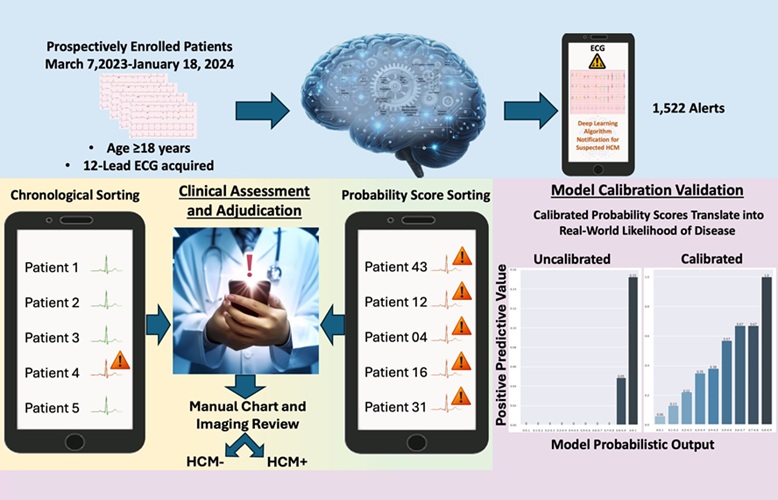Percutaneous Atherectomy System Treats Peripheral Calcifications 
|
By HospiMedica International staff writers Posted on 16 Nov 2014 |

Image: The Stealth 360° Orbital PAD System (Photo courtesy of Cardiovascular Systems).
Novel orbital technology removes plaque buildup in peripheral arterial disease (PAD) and critical limb ischemia (CLI) without damaging the soft arterial tissue.
The Stealth 360° Orbital Atherectomy System (OAS) system is intended to treat calcified and fibrotic plaque in arterial vessels by endarterectomy. The system is based on an orbital mechanism of action that protects healthy tissue, while removing even the most difficult to treat plaque. The electrical-powered handle features a power button and speed selection controls positioned for ease of use and greater physician control. The crown, available in sizes of 1.25, 1.50, 1.75, and 2.00 mm, is designed for maximal plaque removal at lower speeds, with a flexible shaft for compromised run-off, vessel bends, or tortuous anatomy.
The orbital system operates by centrifugal force, which causes the crown to rotate at the same time as it advances through the lesion. As crown rotation increases, centrifugal force presses the crown against the plaque and sands it into tiny particles. More than 99% of the particles are smaller than a red blood cell, and they are washed away with the patient’s blood flow. The elastic, more compliant tissue flexes away from the crown and leaves the non-diseased tissue intact. The result is a smooth, concentric and open vessel that appears to be a normal size and allows robust blood flow.
Additionally, by first removing the hardened plaque and changing the compliance of the lesion by atherectomy, clinicians can subsequently perform low-pressure balloon angioplasty, which may reduce the potential for barotrauma to the vessel during the angioplasty procedure. The Stealth 360° Orbital Atherectomy System (OAS) system is a product of Cardiovascular Systems (CSI; St. Paul, MN, USA), and has received the European Community (CE) marking of approval.
“Securing CE mark for Stealth 360° greatly expands our market opportunity and is an important milestone toward benefiting patients in Europe suffering from PAD, especially those with CLI, who have been underserved by other treatment options,” said David Martin, president and CEO of CSI. “A determining factor for CLI is calcium buildup in leg arteries, particularly small vessels below the knee. Our technology, with its unique mechanism of action, has demonstrated it can safely and effectively treat this complex disease, with lasting results.”
PAD is a narrowing of the peripheral arteries due to atherosclerosis, and is most common in the pelvis and legs. The most common symptoms of PAD are cramping, pain, or tiredness in the leg or hip muscles while walking or climbing stairs, which is temporarily relieved by rest. PAD sufferers have four to five times more risk of heart attack or stroke, and if left untreated, it can lead to gangrene and amputation.
Related Links:
Cardiovascular Systems
The Stealth 360° Orbital Atherectomy System (OAS) system is intended to treat calcified and fibrotic plaque in arterial vessels by endarterectomy. The system is based on an orbital mechanism of action that protects healthy tissue, while removing even the most difficult to treat plaque. The electrical-powered handle features a power button and speed selection controls positioned for ease of use and greater physician control. The crown, available in sizes of 1.25, 1.50, 1.75, and 2.00 mm, is designed for maximal plaque removal at lower speeds, with a flexible shaft for compromised run-off, vessel bends, or tortuous anatomy.
The orbital system operates by centrifugal force, which causes the crown to rotate at the same time as it advances through the lesion. As crown rotation increases, centrifugal force presses the crown against the plaque and sands it into tiny particles. More than 99% of the particles are smaller than a red blood cell, and they are washed away with the patient’s blood flow. The elastic, more compliant tissue flexes away from the crown and leaves the non-diseased tissue intact. The result is a smooth, concentric and open vessel that appears to be a normal size and allows robust blood flow.
Additionally, by first removing the hardened plaque and changing the compliance of the lesion by atherectomy, clinicians can subsequently perform low-pressure balloon angioplasty, which may reduce the potential for barotrauma to the vessel during the angioplasty procedure. The Stealth 360° Orbital Atherectomy System (OAS) system is a product of Cardiovascular Systems (CSI; St. Paul, MN, USA), and has received the European Community (CE) marking of approval.
“Securing CE mark for Stealth 360° greatly expands our market opportunity and is an important milestone toward benefiting patients in Europe suffering from PAD, especially those with CLI, who have been underserved by other treatment options,” said David Martin, president and CEO of CSI. “A determining factor for CLI is calcium buildup in leg arteries, particularly small vessels below the knee. Our technology, with its unique mechanism of action, has demonstrated it can safely and effectively treat this complex disease, with lasting results.”
PAD is a narrowing of the peripheral arteries due to atherosclerosis, and is most common in the pelvis and legs. The most common symptoms of PAD are cramping, pain, or tiredness in the leg or hip muscles while walking or climbing stairs, which is temporarily relieved by rest. PAD sufferers have four to five times more risk of heart attack or stroke, and if left untreated, it can lead to gangrene and amputation.
Related Links:
Cardiovascular Systems
Latest Surgical Techniques News
- DNA Origami Improves Imaging of Dense Pancreatic Tissue for Cancer Detection and Treatment
- Pioneering Sutureless Coronary Bypass Technology to Eliminate Open-Chest Procedures
- Intravascular Imaging for Guiding Stent Implantation Ensures Safer Stenting Procedures
- World's First AI Surgical Guidance Platform Allows Surgeons to Measure Success in Real-Time
- AI-Generated Synthetic Scarred Hearts Aid Atrial Fibrillation Treatment
- New Class of Bioadhesives to Connect Human Tissues to Long-Term Medical Implants
- New Transcatheter Valve Found Safe and Effective for Treating Aortic Regurgitation
- Minimally Invasive Valve Repair Reduces Hospitalizations in Severe Tricuspid Regurgitation Patients
- Tiny Robotic Tools Powered by Magnetic Fields to Enable Minimally Invasive Brain Surgery
- Magnetic Tweezers Make Robotic Surgery Safer and More Precise
- AI-Powered Surgical Planning Tool Improves Pre-Op Planning
- Novel Sensing System Restores Missing Sense of Touch in Minimally Invasive Surgery
- Headset-Based AR Navigation System Improves EVD Placement
- Higher Electrode Density Improves Epilepsy Surgery by Pinpointing Where Seizures Begin
- Open-Source Tool Optimizes Placement of Visual Brain Implants
- Easy-To-Apply Gel Could Prevent Formation of Post-Surgical Abdominal Adhesions
Channels
Critical Care
view channel
Smart Bandage Monitors Chronic Wounds in Human Patients
A future smart bandage, envisioned as a "lab on skin," could assist both patients and caregivers by not only monitoring chronic wounds but also delivering treatment and accelerating the healing process... Read more
AI Identifies Patients with Increased Lung Cancer Risk Up To 4 Months Earlier
Earlier diagnosis plays a crucial role in improving the prognosis of cancer, as delays in starting therapy are associated with decreased survival rates. In most cases, cancer is first identified when symptoms... Read more
AI Algorithm Identifies High-Risk Heart Patients
Hypertrophic cardiomyopathy (HCM) is a complex condition characterized by the thickening of the heart muscle, which impairs the heart's ability to pump blood effectively. This forces the heart to work... Read more
Next Gen Hemodynamic Monitoring Solution Provides AI-Driven Clinical Decision Support
A new cutting-edge hemodynamic monitoring platform, equipped with predictive artificial intelligence (AI)-based algorithms, is designed to help clinicians proactively manage blood pressure fluctuations... Read morePatient Care
view channel
Portable Biosensor Platform to Reduce Hospital-Acquired Infections
Approximately 4 million patients in the European Union acquire healthcare-associated infections (HAIs) or nosocomial infections each year, with around 37,000 deaths directly resulting from these infections,... Read moreFirst-Of-Its-Kind Portable Germicidal Light Technology Disinfects High-Touch Clinical Surfaces in Seconds
Reducing healthcare-acquired infections (HAIs) remains a pressing issue within global healthcare systems. In the United States alone, 1.7 million patients contract HAIs annually, leading to approximately... Read more
Surgical Capacity Optimization Solution Helps Hospitals Boost OR Utilization
An innovative solution has the capability to transform surgical capacity utilization by targeting the root cause of surgical block time inefficiencies. Fujitsu Limited’s (Tokyo, Japan) Surgical Capacity... Read more
Game-Changing Innovation in Surgical Instrument Sterilization Significantly Improves OR Throughput
A groundbreaking innovation enables hospitals to significantly improve instrument processing time and throughput in operating rooms (ORs) and sterile processing departments. Turbett Surgical, Inc.... Read moreHealth IT
view channel
Printable Molecule-Selective Nanoparticles Enable Mass Production of Wearable Biosensors
The future of medicine is likely to focus on the personalization of healthcare—understanding exactly what an individual requires and delivering the appropriate combination of nutrients, metabolites, and... Read more
Smartwatches Could Detect Congestive Heart Failure
Diagnosing congestive heart failure (CHF) typically requires expensive and time-consuming imaging techniques like echocardiography, also known as cardiac ultrasound. Previously, detecting CHF by analyzing... Read moreBusiness
view channel
Expanded Collaboration to Transform OR Technology Through AI and Automation
The expansion of an existing collaboration between three leading companies aims to develop artificial intelligence (AI)-driven solutions for smart operating rooms with sophisticated monitoring and automation.... Read more















